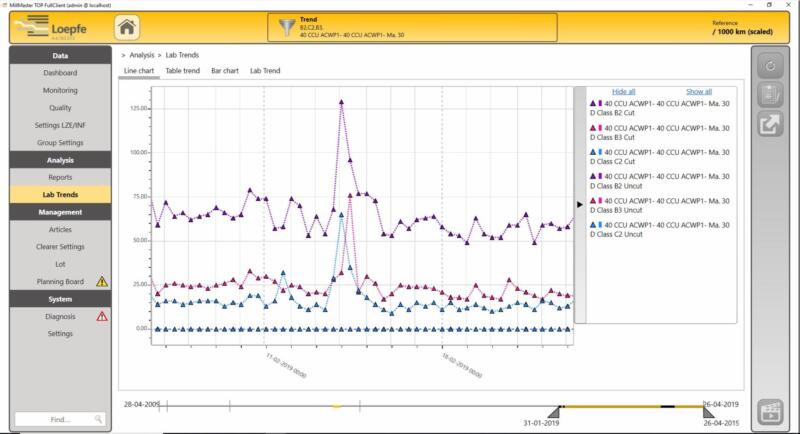Keep track of quality
Lab Trend: example of increasing piecing faults
The Lab Trend reports offered by MillMaster TOP present unlimited possibilities for achieving excellence in yarn production and machine performance. It is an essential tool for mills striving to continuously improve their operations and become trusted partners for quality yarns, while maximizing their profits.
MillMaster TOP provides a comprehensive analysis tool for determining the causes of fluctuating yarn properties. Deviations in yarn quality can result from various reasons, including:
MillMaster TOP provides a comprehensive analysis tool for determining the causes of fluctuating yarn properties. Deviations in yarn quality can result from various reasons, including:
- Raw material change
- Settings changes
- Wear and tear
- Dirt
- Climate change
The clear presentation of quality changes by the Lab Trend gives the spinner the ability to always keep track of changes in the process. Automated data evaluation allows immediate intervention in the event of disruptive incidents which would harm efficiency or quality.

This specific case shows that spinning mills have the chance to utilize the Lab Trend to monitor the quality of the thick places from piecing on the ring spinning machine.
The Lab Trend line chart reveals a significant increase in faults in the classes B2, C2, and B3. A significant number of defects in these classes can cause disruptions in subsequent processes and hurt the overall fabric appearance. That's why it's important to recognize and eliminate such errors.
Targeted actions
The extensive information of the LabTrend can now be compared with the "Classification of Yarn Faults and Their Sources" chart. This powerful combination allows for unparalleled precision in identifying and swiftly correcting any quality issues that may arise throughout the production process. From the raw materials to the ring-spinning process, every stage is now under control, ensuring consistent quality and maximum efficiency.
Possible reasons for rising faults in the classes B2, C2, and B3:
B2:
- Piecing faults
- Damaged aprons
- Unclean drafting unit at ring spinning frame
- Fiber fly accumulation due to improper maintenance in spinning
- Eccentricity of apron rollers High speed on ring spinning frame
- Improper piecing at detaching rollers of combing
C2:
- Improper roller setting and break draft in ring spinning frame
- Drafting faults in ring spinning frame
- Spacers size selection in spinning
B3:
- Fiber fly at spinning triangle
- Improper break draft in ring spinning frame
- Unclean drafting unit at ring spinning frame
- Worn-out top roller cots
This list indicates that the temporary increase in classes: B2, B3, C2, is probably due to piecing faults on the ring-spinning machine. The Lab Trend feature provides a clear and understandable overview of quality fluctuations, enabling spinners to monitor process changes continuously. The automated data evaluation is particularly valuable as it allows for immediate intervention when disruptive incidents occur, thereby safeguarding both efficiency and yarn quality.